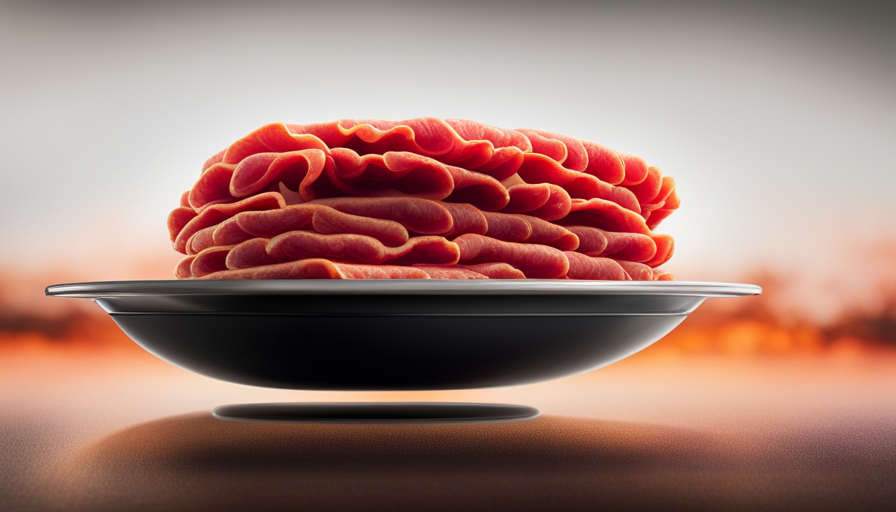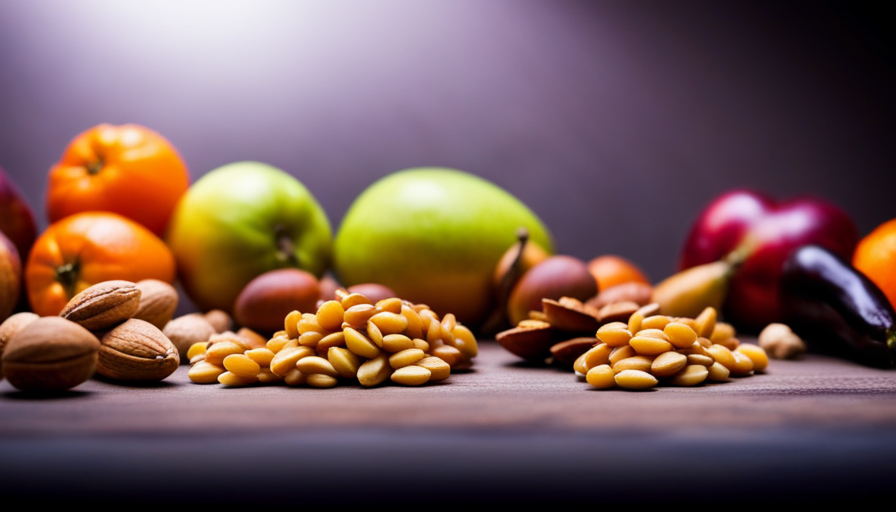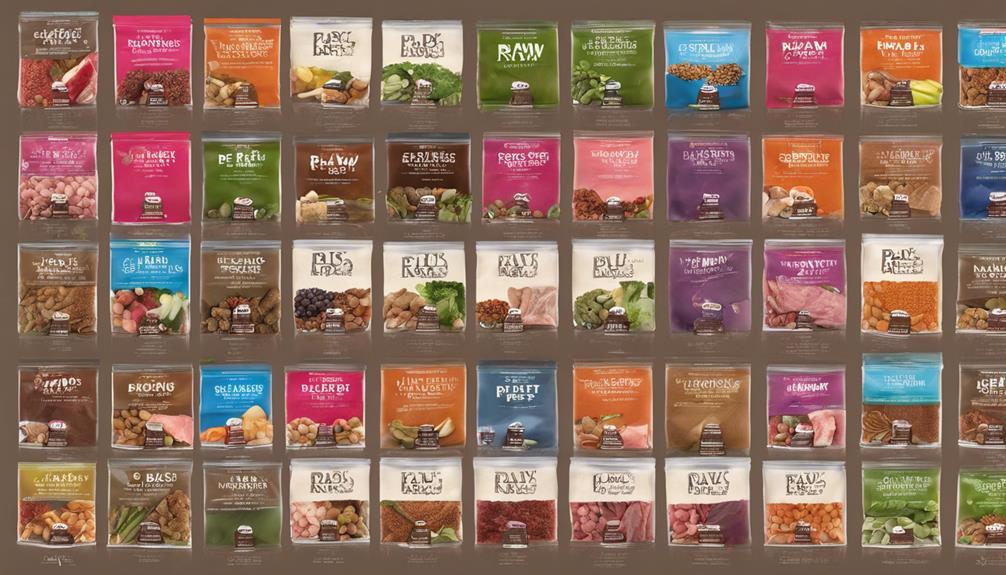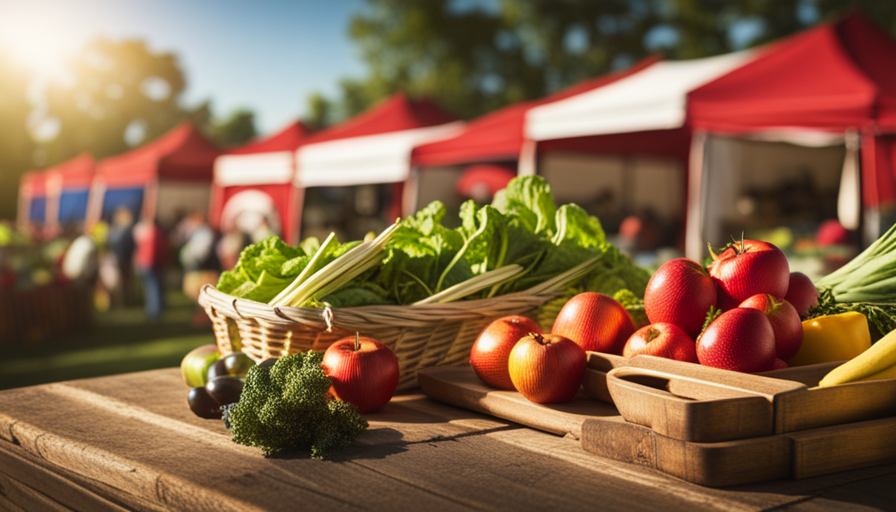As a dog parent, I understand the happiness and duty that comes with caring for a puppy. One crucial aspect of their well-being is their nutrition. While commercial puppy food is commonly used, many pet parents are now opting for a healthier and more natural alternative: raw food.
But when is the right time to introduce raw food to your furry friend? In this article, we will explore the benefits of raw food for puppies and the risks to consider. We will also discuss the guidelines for introducing raw food, transitioning from commercial food, and common mistakes to avoid. Additionally, we will delve into monitoring your puppy’s health and adjusting their diet as they grow.
So, if you’re curious about when your puppy can start enjoying the benefits of a raw food diet, keep reading for all the information you need.
Key Takeaways
- Raw food can be a natural and nutritious option for puppies.
- Puppies can benefit from raw food as it provides a balanced combination of proteins, fats, and carbohydrates, retains vital nutrients, and promotes overall health.
- However, there are potential risks associated with feeding raw food to puppies, such as bacterial contamination, nutrient imbalances, and choking hazards.
- When introducing raw food to puppies, it is important to follow guidelines such as a gradual transition, mixing small amounts with regular food, and monitoring their health.
The Benefits of Raw Food for Puppies
Feeding raw food to puppies is like giving them a ticket to a delicious, nutrient-packed adventure for their growing bodies. The transitioning process from traditional kibble to raw food can be a bit challenging, but the benefits it provides are well worth the effort.
Raw food offers a plethora of nutritional benefits that can support a puppy’s overall health and development. One of the main advantages of raw food is that it closely resembles a dog’s natural diet in the wild. This means it contains a balanced combination of proteins, fats, and carbohydrates, which are essential for a puppy’s growth. Raw food also retains vital nutrients that may be lost during the cooking process, such as enzymes, vitamins, and minerals. These nutrients play a crucial role in maintaining a strong immune system, promoting healthy digestion, and supporting optimal brain function.
Additionally, raw food can improve a puppy’s coat condition and skin health. The high-quality proteins found in raw food contribute to a glossy and lustrous coat. Raw food also contains a good balance of omega-3 and omega-6 fatty acids, which are essential for maintaining healthy skin and reducing inflammation.
Before embarking on the raw food journey, it’s important to consider the risks involved. However, these risks can be mitigated by sourcing high-quality ingredients and following proper food handling and storage protocols. Transitioning to raw food may require some adjustments, but the long-term benefits for a puppy’s health and well-being make it a worthwhile choice.
Risks to Consider Before Feeding Raw Food
Before feeding raw food to puppies, it’s essential to consider the potential risks associated with this diet.
One significant risk is the potential bacterial contamination that raw food can carry, which can lead to foodborne illnesses.
Additionally, feeding raw food may result in an imbalance of nutrients, as it can be challenging to ensure that all essential vitamins and minerals are included in the diet.
Lastly, raw food can pose choking hazards, especially if bones or large pieces are not properly prepared or if the puppy doesn’t chew their food thoroughly.
Potential bacterial contamination
Although raw food diets for puppies have gained popularity, there’s a concerning possibility of potential bacterial contamination. Feeding puppies raw food can expose them to harmful bacteria such as Salmonella or E. coli. These bacteria can cause serious health issues, including diarrhea, vomiting, and in severe cases, even death.
To minimize the potential health risks associated with raw food diets, it’s essential to take proper food safety precautions. This includes handling raw food properly, keeping it refrigerated, and cleaning all utensils and surfaces thoroughly. Additionally, it’s important to source raw food from reputable suppliers who follow stringent quality control measures. By following these food safety precautions, the risk of bacterial contamination can be significantly reduced.
Transitioning to the subsequent section about the ‘imbalance of nutrients’, it’s crucial to carefully consider the nutritional requirements of puppies when planning a raw food diet.
Imbalance of nutrients
One crucial aspect to consider when planning a raw diet is the potential for an imbalance of nutrients. While raw food can provide numerous health benefits for puppies, it’s important to ensure that they receive a well-balanced diet to avoid nutritional deficiencies.
A raw diet primarily consists of meat, bones, and organs, which may lack certain essential nutrients like carbohydrates and fiber. This can lead to imbalances in vitamins, minerals, and other essential nutrients, potentially affecting the overall health of the puppy. It’s important to consult with a veterinarian or a canine nutritionist to ensure that the raw diet includes all the necessary nutrients in appropriate quantities. Failure to address these nutritional deficiencies can result in health risks for the puppy.
Moving forward to the next section about ‘choking hazards,’ it’s crucial to consider additional factors that can impact the safety of feeding puppies a raw diet.
Choking hazards
Be careful when feeding your furry friend a raw diet, as there are potential choking hazards that you need to be aware of. Choking hazards can occur when puppies are given large chunks of raw meat or bones that are too big for them to handle. To prevent choking, it’s important to feed puppies appropriately sized portions of raw food.
This means cutting meat into small, manageable pieces and avoiding large bones altogether. Additionally, it’s crucial to supervise your puppy while they’re eating to ensure they don’t gulp down their food without chewing properly.
By following these prevention techniques, you can reduce the risk of choking and keep your puppy safe during mealtime.
Now, let’s move on to when puppies can start eating raw food.
When Can Puppies Start Eating Raw Food?
You can start feeding your puppies raw food when they reach a certain age. Transitioning them to a raw food diet has numerous benefits for their overall health and well-being. Raw food provides essential nutrients and enzymes that are often lost during the cooking process. It promotes healthy digestion, improves skin and coat condition, and strengthens their immune system.
To grab your attention, let me present a table outlining the benefits of raw food for puppies:
| Benefits of Raw Food for Puppies | |
|---|---|
| Improved digestion | Healthier skin and coat |
| Stronger immune system | Enhanced energy levels |
| Better dental health | Lower risk of obesity |
Now, let’s discuss the guidelines for introducing raw food to puppies. It’s important to gradually introduce raw food into their diet to prevent digestive issues. Start by mixing a small amount of raw food with their regular food, gradually increasing the proportion over a week or two. Monitor their stools and overall health during this transition period. Remember to consult with your veterinarian to ensure a smooth and successful transition.
Moving forward, let’s delve into the guidelines for introducing raw food to puppies without any disruption in their health and well-being.
Guidelines for Introducing Raw Food to Puppies
To ensure a smooth transition, it’s crucial to gradually introduce a raw diet to your furry companions. Transitioning from commercial puppy food to raw food requires careful planning and consideration. Here are some transitioning tips to help you make the switch successfully:
-
Start by substituting a small portion of their regular puppy food with raw food. This allows their digestive system to adjust slowly.
-
Gradually increase the proportion of raw food over several weeks. This helps prevent any digestive upset or discomfort.
-
Monitor your puppy’s response to the new diet closely. Look for signs of allergies or digestive issues, and consult with a veterinarian if necessary.
-
Ensure proper meal proportions by following a balanced raw diet recipe or consulting with a veterinary nutritionist. It’s important to provide the right amount of protein, fat, and carbohydrates for your growing puppy.
Transitioning from commercial puppy food to raw food is an important decision that requires careful consideration. By following these guidelines and monitoring your puppy’s response, you can help them thrive on a raw diet.
Transitioning from Commercial Puppy Food to Raw Food
When transitioning a puppy from commercial puppy food to a raw food diet, it’s important to do so gradually to avoid digestive upset. Start by replacing a small portion of the puppy’s regular food with raw food, increasing the proportion over time. This allows their digestive system to adjust to the new diet.
There are several tips to consider during this transition. First, make sure the raw food you choose is nutritionally balanced and specifically formulated for puppies. Look for reputable brands that follow strict quality control measures and have a good track record for producing safe and healthy raw food. Some recommended raw food brands for puppies include ABC Raw, XYZ Raw, and PQR Raw.
Introducing raw food to puppies can be a beneficial dietary choice, as it provides them with the nutrients they need for optimal growth and development. However, it’s essential to follow proper food handling and preparation techniques to minimize the risk of bacterial contamination.
In the next section, we’ll discuss the necessary steps to prepare and handle raw food for puppies without compromising their health and safety.
Preparing and Handling Raw Food for Puppies
When it comes to preparing and handling raw food for puppies, there are key points that should be kept in mind. Proper storage and thawing techniques are essential to maintain the quality and safety of the food.
Safe food handling practices should be followed to prevent contamination and the spread of harmful bacteria. Additionally, it’s important to regularly clean and disinfect food bowls and utensils to ensure a hygienic feeding environment for your puppy.
Proper storage and thawing techniques
Make sure you store the raw food in airtight containers and thaw it in the refrigerator overnight, so your puppy can indulge in a delicious and healthy meal.
When it comes to thawing techniques, there are a few things to keep in mind. First, never thaw raw food at room temperature, as this can promote bacterial growth. Instead, opt for the refrigerator method to ensure a safe thawing process. Second, avoid thawing raw food in the microwave, as this can unevenly heat the food and potentially destroy essential nutrients. Lastly, make sure to handle the thawed raw food with clean hands and separate it from other foods to prevent cross-contamination.
By following these proper storage and thawing techniques, you can provide your puppy with a nutritious meal that is safe to eat.
Moving on to safe food handling practices, it is important to…
Safe food handling practices
One way to ensure a delightful and worry-free meal for your furry friend is by practicing safe food handling techniques. Safe handling practices are essential to maintain food safety for your puppy.
When preparing raw food for your puppy, it’s important to follow proper hygiene practices to prevent the spread of harmful bacteria. This includes washing your hands thoroughly before and after handling raw food, as well as cleaning and disinfecting all surfaces and utensils used in the preparation process.
Additionally, it’s crucial to store raw food properly to maintain its freshness and prevent contamination. Ensuring that raw food is stored at the correct temperature and separate from other foods can help reduce the risk of foodborne illnesses.
By incorporating these safe handling practices, you can provide your puppy with a healthy and nourishing meal.
Moving on to cleaning and disinfecting food bowls and utensils…
Cleaning and disinfecting food bowls and utensils
When it comes to safe food handling practices for puppies eating raw food, it’s not just about the quality of the food itself, but also the cleanliness of the bowls and utensils used during feeding. Proper cleaning and disinfecting techniques are crucial to maintain food safety standards and ensure the well-being of your furry friend.
To clean food bowls and utensils effectively, follow these steps:
-
Wash with hot, soapy water: Use a mild dish soap to thoroughly clean the bowls and utensils, removing any food residue.
-
Rinse with hot water: Rinse off the soap under hot running water to remove any remaining residue.
-
Disinfect: Use a food-safe disinfectant or a mixture of one part bleach to ten parts water to sanitize the bowls and utensils.
By implementing these cleaning techniques, you can reduce the risk of bacterial contamination and keep your puppy healthy.
Now, let’s move on to common mistakes to avoid when feeding raw food.
Common Mistakes to Avoid When Feeding Raw Food
To ensure a smooth transition to raw food, it’s fascinating to note that 75% of puppy owners mistakenly feed their pets a diet lacking in essential nutrients. Common misconceptions often lead to these mistakes.
One common misconception is that puppies can eat the same raw food as adult dogs. However, puppies have different nutritional needs and require a diet specifically formulated for their growth and development.
Another misconception is that raw food alone is enough to provide all the necessary nutrients. In reality, a balanced raw food diet should include a variety of meats, bones, organs, fruits, and vegetables.
Transitioning your puppy to a raw food diet requires careful planning and consideration. Start by introducing small amounts of raw food gradually, mixed with their current diet. Over time, increase the proportion of raw food while decreasing the amount of kibble or canned food. This will help their digestive system adjust to the new diet. Additionally, it’s crucial to consult with a veterinarian or a canine nutritionist to ensure your puppy’s diet meets their specific needs.
Monitoring your puppy’s health and well-being on a raw food diet is essential. Regularly check their body condition, weight, and stool quality to ensure they are thriving. Any changes in appetite, energy levels, or physical appearance should be addressed promptly. By keeping a close eye on your puppy’s health, you can make adjustments to their diet if necessary.
Transitioning to a raw food diet requires careful attention and monitoring, but with the right approach, your puppy can thrive on this natural and nutritious diet.
Monitoring Your Puppy’s Health and Well-being on a Raw Food Diet
When feeding my puppy a raw food diet, it’s crucial to regularly schedule veterinary check-ups to ensure their overall health and well-being.
During these visits, the vet can assess my puppy’s overall appearance and behavior to identify any potential issues or areas of concern.
Additionally, monitoring stool quality and consistency is important as it can indicate the effectiveness of the raw food diet and any potential digestive issues that may arise.
Regular veterinary check-ups
Regular veterinary check-ups are crucial for puppies to ensure their health and well-being. It’s important to follow veterinary recommendations for preventive care to keep your puppy in optimal condition.
During these check-ups, the veterinarian will perform a thorough examination of your puppy, checking for any signs of illness or abnormalities. They’ll also administer necessary vaccinations and provide guidance on nutrition and exercise.
Additionally, regular check-ups allow the veterinarian to monitor your puppy’s growth and development, ensuring they are meeting important milestones. By scheduling these appointments, you can catch any potential health issues early on and address them promptly. This’ll help your puppy maintain good overall health and prevent future complications.
Moving forward, assessing your puppy’s overall appearance and behavior will further contribute to their well-being.
Assessing your puppy’s overall appearance and behavior
Take a moment to observe your puppy’s overall appearance and behavior – did you know that studies have shown that wagging their tail to the right indicates positive emotions, while wagging to the left can indicate anxiety or fear? When assessing your puppy, it is important to evaluate their growth and energy levels. This can help determine if they are developing properly and if their nutritional needs are being met. A simple way to assess growth is by measuring their weight and comparing it to the breed’s average growth chart. Additionally, evaluating their energy levels can give insight into their overall health and well-being. A puppy with consistent energy levels and a playful demeanor is generally a good sign. Transitioning into the next section about monitoring stool quality and consistency, it is important to note that assessing your puppy’s overall appearance and behavior can give valuable information about their digestive health.
Monitoring stool quality and consistency
Keep an eye on your puppy’s poop to ensure that it’s healthy and consistent. Stool analysis is an important tool in monitoring your puppy’s overall health and assessing the effectiveness of their raw food diet.
By regularly checking the quality and consistency of their stool, you can identify any potential issues such as diarrhea, constipation, or abnormal color. This information can help you make necessary dietary adjustments to ensure your puppy is receiving the proper nutrients and maintaining optimal digestive health.
If you notice any abnormalities in your puppy’s stool, consult with your veterinarian for further guidance. Adjusting the raw food diet as your puppy grows is crucial for their development and well-being.
Adjusting the Raw Food Diet as Your Puppy Grows
As your puppy grows, it’s quite a spectacle to witness how their raw food diet evolves. Here are three key aspects to consider when adjusting the raw food diet for your growing puppy:
-
Adjusting portion size: As your puppy goes through different growth stages, their nutritional needs will change. It’s important to adjust the portion size of their raw food accordingly. Monitor their body condition and consult with a veterinarian to ensure they’re getting the right amount of food for optimal growth and development.
-
Introducing new protein sources: Variety is essential in a raw food diet to provide a wide range of nutrients. As your puppy grows, you can gradually introduce new protein sources to their diet. This helps prevent sensitivities or allergies from developing and ensures they receive a balanced diet. Consider adding protein sources like lamb, fish, or rabbit to their meals.
-
Monitoring nutrient requirements: As your puppy grows, their nutrient requirements may change. It’s important to regularly assess their nutritional needs and make adjustments accordingly. This includes ensuring they receive adequate amounts of essential nutrients like calcium, phosphorus, and omega-3 fatty acids for healthy bone and joint development.
As you continue to adjust their raw food diet and provide the best nutrition for your growing puppy, it’s important to have additional resources and support. These can include consulting with a veterinary nutritionist, joining raw feeding communities, or seeking guidance from reputable raw food suppliers.
Transitioning to the next section, these resources will provide valuable information and assistance for feeding raw food to puppies.
Additional Resources and Support for Feeding Raw Food to Puppies
Now that you have learned about adjusting the raw food diet as your puppy grows, let’s explore additional resources and support for feeding raw food to puppies. It’s important to have access to reliable information and assistance when embarking on this feeding method. Thankfully, there are several resources available to help you navigate the process.
One valuable resource is online forums and communities dedicated to raw feeding. These platforms allow you to connect with experienced raw feeders who can provide guidance and answer any questions you may have. Additionally, many raw food suppliers offer educational materials and support to their customers. They may have online resources such as articles, videos, and feeding guides that can assist you in understanding the nutritional requirements of your growing puppy.
Another option is seeking advice from holistic veterinarians or animal nutritionists who specialize in raw feeding. They can provide personalized recommendations tailored to your puppy’s specific needs. Additionally, some veterinary clinics offer raw feeding consultations or workshops where you can learn more about the benefits and best practices of this diet.
By utilizing these additional resources and support systems, you can ensure that you have the knowledge and assistance necessary to provide your puppy with a balanced and nutritious raw food diet. Remember, feeding raw food to puppies requires careful consideration, so take advantage of these resources to make informed decisions for your furry friend.
Frequently Asked Questions
Can puppies eat raw food if they have a sensitive stomach?
Yes, puppies can still eat raw food even if they have a sensitive stomach or digestive system. Raw food diets for puppies can provide numerous benefits, such as improved coat condition, increased energy levels, and better overall health. However, it’s important to introduce raw food gradually and monitor their response.
Some puppies with sensitive stomachs may require a slower transition or specific adjustments to the raw food diet to avoid digestive issues.
Is it safe to feed raw food to puppies with a compromised immune system?
Feeding raw food to puppies with a compromised immune system isn’t recommended. A raw food diet may contain harmful bacteria that can pose a greater risk to puppies with weakened immune systems. It’s crucial to prioritize their health and consult with a veterinarian before introducing any dietary changes. A compromised immune system requires special care, and a veterinarian can provide guidance on the most suitable diet to support the puppy’s specific needs.
Are there any specific breeds that should not be fed a raw food diet?
There are certain breeds that may not be suitable for a raw food diet. Breeds such as Dalmatians, Bulldogs, and Basset Hounds are prone to certain health conditions that could be exacerbated by a raw food diet. These conditions include urinary tract issues and pancreatitis.
It’s important to consult with a veterinarian before starting any dog, especially these breeds, on a raw food diet to ensure their specific health needs are met.
Can puppies eat raw food if they have food allergies?
Puppies with food allergies or sensitive stomachs can still eat raw food, but it’s important to choose the right ingredients. Raw food diets for puppies with allergies should focus on novel proteins and limited ingredient options to avoid triggering allergic reactions.
Additionally, it’s recommended to consult with a veterinarian or a veterinary nutritionist to ensure that the raw food diet meets all the nutritional needs of the puppy while addressing their specific allergies or sensitivities.
What are the potential long-term effects of feeding a puppy a raw food diet?
Feeding a puppy a raw food diet may pose potential risks and nutritional deficiencies in the long term. Raw diets may lack essential nutrients, leading to imbalances and deficiencies that can impact the puppy’s growth and development.
Insufficient calcium and phosphorus ratios, for example, may affect bone formation. Moreover, raw food may contain harmful bacteria like Salmonella or E. coli, potentially causing infections in both puppies and humans.
It’s crucial to carefully consider the potential consequences before opting for a raw food diet for puppies.
Is It Safe to Feed Raw Food to Puppies Despite the Potential Cons?
Feeding raw food to puppies can be risky due to the cons of raw food diet. Potential hazards include bacterial contamination, nutrient imbalances, and potential choking hazards from bones. It’s important to consult with a veterinarian before switching your puppy to a raw food diet to ensure their health and safety.
Conclusion
In conclusion, feeding raw food to puppies can have numerous benefits for their overall health and well-being. While there are risks to consider, such as bacterial contamination and nutritional imbalances, these can be minimized with proper guidelines and monitoring.
It is crucial to introduce raw food gradually and transition from commercial puppy food to ensure a smooth transition. By avoiding common mistakes and adjusting the diet as the puppy grows, we can provide them with the optimal nutrition they need.
With the right resources and support, feeding raw food to puppies can be a rewarding and beneficial choice.










